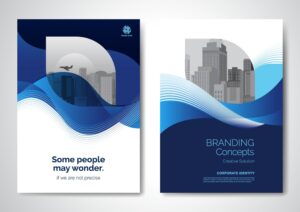Building a Strong Brand Identity with Graphic Design
Introduction
Branding and Identity: In today’s highly competitive marketplace, establishing a strong brand identity is crucial for any business aiming to stand out. A well-defined brand identity not only communicates who you are but also shapes how your audience perceives you. Graphic design plays a pivotal role in building and maintaining this identity, ensuring that every visual element resonates with your brand’s values and mission. In this blog, we’ll explore how you can use graphic design to build a strong and cohesive brand identity.
The Role of Graphic Design in Branding and Identity
Why Brand Identity Matters
Your brand identity is the collection of all elements that a company creates to portray the right image to its consumer. It encompasses everything from your logo and color scheme to your website and social media presence. A strong brand identity makes your business recognizable, builds trust, and fosters customer loyalty. It’s the foundation of your brand’s image and is essential for creating a lasting connection with your audience.
Graphic Design: The Visual Language of Your Brand
Graphic design is the visual language through which your brand communicates. It involves the strategic use of colors, typography, imagery, and layout to convey your brand’s personality and values. Whether it’s through a sleek website design, a memorable logo, or eye-catching marketing materials, graphic design ensures that your brand’s identity is consistently and effectively communicated.
Key Elements of a Strong Branding and Identity
1. Logo Design
The logo is often the most recognizable element of a brand’s identity. It’s a visual representation of your business that appears on everything from business cards to websites. A well-designed logo should be simple, memorable, and reflective of your brand’s essence. It serves as the anchor for your brand identity, setting the tone for all other design elements.

2. Color Palette
Color is a powerful tool in graphic design that can evoke emotions and influence perceptions. Your brand’s color palette should be chosen carefully to reflect your brand’s personality. For example, blue is often associated with trust and professionalism, while red can evoke excitement and passion. A consistent color palette across all brand materials helps reinforce your identity and makes your brand more recognizable.
3. Typography
Typography is more than just the fonts you use; it’s a crucial part of your brand’s visual identity. The right typography can communicate professionalism, creativity, elegance, or any other trait that aligns with your brand’s personality. Consistent use of typography across all platforms ensures that your brand’s voice is clear and cohesive.
4. Imagery and Visual Style
The images and visual style you choose are vital components of your brand identity. Whether you opt for minimalist photography, bold illustrations, or abstract graphics, your visual style should align with your brand’s message. Consistent imagery across your website, social media, and marketing materials reinforces your brand’s identity and helps create a unified look.
5. Design Layout and Composition
How you arrange design elements on a page—whether in a brochure, website, or social media post—affects how your audience perceives your brand. A clean, well-organized layout communicates professionalism and attention to detail, while a more dynamic composition can convey creativity and innovation. Consistency in layout and composition across all brand materials ensures a cohesive visual identity.
Using Graphic Design to Strengthen Branding and Identity
Consistency is Key
Consistency in graphic design is critical to building a strong brand identity. Every piece of visual content—from your website to your social media graphics—should be instantly recognizable as part of your brand. This consistency not only reinforces your brand identity but also builds trust with your audience, as they know what to expect from your brand.
Adaptability and Flexibility
While consistency is important, it’s also crucial that your brand identity is adaptable. As your business grows and evolves, your graphic design should be flexible enough to accommodate new trends and changes without losing the core elements of your identity. This adaptability ensures that your brand remains relevant and continues to resonate with your audience.
Tell Your Brand’s Story
Graphic design is a powerful tool for storytelling. Every element of your design, from colors and fonts to images and layouts, should work together to tell your brand’s story. This story is what connects with your audience on an emotional level, creating a deeper bond and fostering loyalty.
Conclusion
Building a strong brand identity with graphic design involves more than just creating a logo or choosing a color scheme. It’s about creating a cohesive visual language that communicates your brand’s values, personality, and story. By focusing on consistency, adaptability, and storytelling, you can use graphic design to create a brand identity that not only stands out but also resonates with your audience. Ready to strengthen your brand’s identity through powerful graphic design? Contact us today to get started.
For more insights on building a strong brand identity, check out Brand New for the latest in brand identity design, or visit Design Shack for design inspiration and tips.
Explore more related articles to deepen your understanding and make informed choices about graphic design techniques
Why Custom Website Development is Essential for Your Brand
How to Choose the Best Graphic Design Services for Your Business







